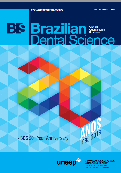Effect of shear bond strength of metallic orthodontic brackets bonded with and without dental adhesive
DOI:
https://doi.org/10.14295/bds.2018.v21i4.1597Abstract
Objective: The aim of this study was to evaluate the shear bond strength (SBS) of two materials for bonding orthodontic brackets on dental enamel before and after thermocycling. Material and Methods: Forty bovine incisors were divided into four groups (n=10). All teeth were etched with 35% phosphoric acid (3M Espe). For bonding of the brackets, G1 and G2 received orthodontic composite resin (Fill Magic Ortodôntico) and G3 and G4, an adhesive (ScotchBond) was used before the orthodontic resin Transbond XT (3M Unitek). G1 and G3 were kept at 37ºC for 24h and G2 and G4 were submitted to thermocycling (5000 cycles, at 5ºC - 55ºC) prior to SBS testing, performed by a universal machine (EMIC) at 1 mm/min, with a 50kgf load cell. Results were analyzed with two-way ANOVA, followed by Tukey's test (p=0.05). Adhesive surfaces were evaluated through stereomicroscopy and classified according to the type of failure presented. Results: Surface treatment with dental adhesive presented higher SBS values, regardless thermocycling (G3: 12.01 MPa; G4: 12.36 MPa) and the lowest values occurred in G2 (8.89 MPa). For groups without adhesive and with thermocycling, a higher number of completely adhesive failures between composite and enamel were present. For groups in which dental adhesive was used, regardless thermocycling, the failures were mainly adhesive between composite and the bracket. Conclusion: Surface etching of enamel with 35% phosphoric acid with or without adhesive showed a positive effect on SBS. The application of adhesive on enamel surface contributed to the maintenance of SBS values after thermocycling.
Keywords
Aging; Orthodontic brackets; Composite resins; Shear strength.
Downloads
Downloads
Published
How to Cite
Issue
Section
License
Brazilian Dental Science uses the Creative Commons (CC-BY 4.0) license, thus preserving the integrity of articles in an open access environment. The journal allows the author to retain publishing rights without restrictions.
=================




























